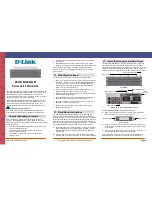
28
2.13 Sensors
The Sensors menu shows real time feedback about different hardware components in the
system such as the CPU, motherboard power output, and CMOS battery. Values are up-‐
dated each time this page is loaded. They define the lower and upper limits of acceptable
usage and warn if there is any malfunction with the monitored components – like for in-‐
stance if power output is below an acceptable level. If any sensors in the QOS system
show status bad, call QOS Technical Support as soon as possible.
3.3V:
The +3.3V power output as seen from the motherboard. This voltage is especially
important for the CPU.
12V:
The +12V power output as seen from the motherboard. This voltage is especially
important for powering the motors on the hard drives as well as the fans in the system.
5V:
The +5V power output as seen from the motherboard. This voltage operates the ma-‐
jority of electrical circuits within the system.
Batt:
The voltage of the CMOS battery. This battery retains the settings for booting the
array when the system is off or unplugged.
2.14 Adapters
The Adapter Details menu contains information about the Fibre connection status and al-‐
lows you to manually configure the Network settings for the QOS 8-‐Bay’s two Ethernet
ports. If it is not possible to connect to NumaRAID to change the IP Address, the next best
way is to use the keyboard and monitor or Telnet approach outlined in Chapter 3 ‘Chang-‐
ing the IP Address of the QOS Ethernet Ports.’ The table at the top of the Adapters menu
labeled NumaRAID Network Management will have two ports listed, Eth0 and Eth1, that
represent the two Ethernet ports on the back of the QOS. There is a dropdown to enable
DHCP (Dynamic Host Configuration Protocol) and a field to manually enter a static IP and
Subnet Mask.
Unless it is used in an advanced network set up, the QOS 8-‐Bay should have a static IP ad-‐
dress with DHCP disabled. In direct-‐attached applications, the two ports can be config-‐
ured as the same IP, but in shared environments the two ports should be set on separate
IP Ranges to avoid conflicts. IP Range refers to the first three numbers of the four number
IP Address. One example of a usable shared configuration would be Eth0 10.0.1.101 and
Eth1 10.0.2.101. An example of direct-‐attached clients would be Eth0 10.0.1.101 and
Eth1 10.0.1.101. When connecting a client computer to the Ethernet port, the first three
numbers must fall in the same Ethernet range as the QOS Server port address and the
fourth number should be different from all other devices on the network. For more in-‐
formation on Client Network Configuration see the Chapter 1 ‘Client Network Configura-‐
tion.’ An Ethernet connection is only required in non-‐shared setups to managing the
RAID, and is not required to access the storage.
QOS 8-Bay User Manual
QOS Server is a subsidary of Ocean Tides Productions Ltd. © Copyright 2013









































